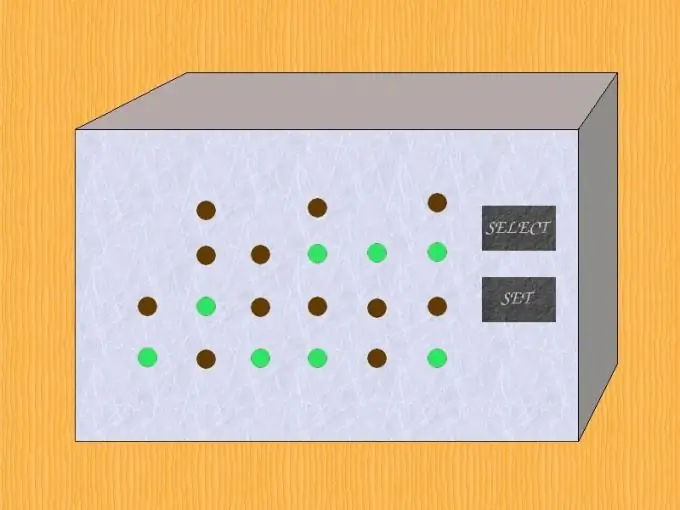- Author Nora Macey [email protected].
- Public 2023-12-16 10:17.
- Last modified 2025-01-23 08:48.
Binary clocks, also called binary clocks, are popular among information technology professionals. With the help of this accessory, they emphasize their belonging to the profession of a programmer, system administrator, web designer. Similar to other clocks without external synchronization, binary clocks need to be adjusted periodically.

Instructions
Step 1
Learn to read a binary clock indicator (if you already know how to do this, skip this step). Each subsequent bit of a binary number has a "weight" twice the previous one, for example, 1, 2, 4, 8, 16, 32. If the bits are located horizontally, the least significant of them will be on the right, and if vertically - at the bottom. To convert a binary number to decimal, it is enough to add the values of the digits together. For example, the number 101011 stands for 32 + 0 + 8 + 0 + 2 + 1 = 43. Some binary clocks display is not binary, but binary-decimal. This means that the number in them is first broken into decimal digits, and then each of them is translated into binary code separately. The same number 43 in binary-decimal system will be written as follows: 0100 (0 + 4 + 0 + 0 = 4) 0011 (0 + 0 + 2 + 1 = 3).
Step 2
The exact order in which a binary clock is set to the current time depends on its model. It is impossible to cover all their varieties within one article. Most often, the instrument has two buttons labeled Select and Set. The first of them is used to select values (hours, minutes or seconds), and the second is to set their values. Press the Select button and the hour will start flashing. Press the Set key to set the readings, which will cycle from 0 to 12 or 24 each time you press it, and then reset to zero. Holding down the button will increase the register value automatically. The speed of this process depends on the watch model. When the reading approaches the desired one, release the button, and then set them exactly with short successive presses.
Step 3
Now press the Select button again. The minutes will now start flashing. The only difference here is that they change from 0 to 59. After setting the minutes, press Select again. A watch that is not able to indicate seconds will exit the setting mode, and those having this function will go into the seconds setting mode. When you hear the exact time signal on the radio, press Set, and the seconds will be reset to zero. If they previously exceeded 31 seconds inclusive, at the same time the number in the counter of minutes will increase by one. Now return the watch to operating mode by pressing the Select button again. You may also have to set the day and month in the same way before this, but this is unlikely, since the calendar in binary clocks is less common than in decimal ones.
Step 4
It is much more convenient if instead of one Select button there are two, next to which are arrows pointing in different directions. An up or right arrow key acts in the same way as the Set key. Use the same one with the arrow pointing down or to the left to decrease the readings if you accidentally missed the necessary ones, or if you can get to the desired number faster.
Step 5
Desktop binary clocks sometimes have the same logic as desktop decimal clocks. Press and hold the Set button to set them. Then use the Hour button to set the hour counter, and the Minute button to set the minute counter. Only then release the Set key. Using the Alarm key instead, you can set the alarm time. Use the Alarm on / off switch to turn it on and off.






